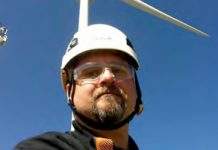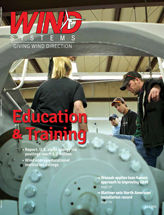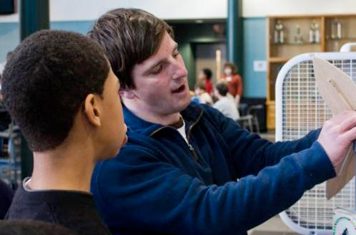The state of Iowa has long been connected with agriculture, but today there are new farms — wind farms — sprouting up in America’s heartland.
A national leader in wind energy, Iowa generates more than one-quarter of its electricity from wind. As future projects are planned, demand will only grow. For instance, Iowa is currently generating 5,600 megawatts of wind but expects that number to exceed 7,000 megawatts by 2017.
“We anticipate a great need for technicians to take care of wind energy equipment,” said Darin Moeller, executive dean of instruction at Western Iowa Tech Community College in Sioux City, Iowa.
Moeller’s right. The number of wind turbines in Iowa and the United States continues to increase, as does the need for skilled workers able to install, maintain, service, and operate them.
Options and opportunities
To meet the need, the college has built a top-notch wind energy technician program at its satellite campus in nearby Cherokee, Iowa. This field of study trains students as technicians and/or operators based on whether they choose WITCC’s one-year diploma option or two-year associate degree.
Students pursue the wind energy technician program for different reasons. For some, it provides practical training that can lead to a good job and a better life. For others, it’s a chance to connect with the growing green movement and make a positive impact on the environment.
Course work covers wind energy turbine systems, of course, along with electrical theory, industrial electronics, instrumentation, principles of motors, and more. Also included are credit hours in physical fitness — a valuable foundation since wind techs climb up to 200 feet on the way to their workplace.
At the top of the turbine, they work in a space roughly the size of a small bus and work on high-voltage circuitry amidst some 8,000 parts.
Western Iowa Tech’s program prepares them to rise to the challenge.
All wind energy instructors have experience in the field, so they lend a level of expertise that’s particularly helpful. “They’ve been there, done that,” said Moeller. “They can really prepare students for issues to expect in the industry.”
Ultimate hands-on training
What’s more, students gain hands-on experience using an 80-foot turbine installed by wind and solar specialists out of Alta, Iowa.
“This resource provides immediate access for our students,” explained Dr. Terry Murrell, WITCC president. “That’s key to their training in this area.”
College officials hope to one day harvest the energy from this turbine and help power the institution. For now, it’s the most visible lab on campus.
“We want to provide all students with realistic experiences similar to the ones they’ll find in their jobs,” Moeller explained. “For this program, having the turbine that students can climb up and monitor … it takes their opportunities to a whole new level.”
Having a turbine on campus exemplifies the college’s commitment level to the cause, noted Moeller. “This was identified as a priority for the wind energy technician program, and it came to fruition through great partnerships.”
Students are excited about the turbine, shared Dr. Darla Struck, who directs Western Iowa Tech’s campus in Cherokee. “They had a hand in its construction, and they’re involved with every facet of running this windmill — all the maintenance, operation, and production that goes along with creating energy for a power grid.”
Perhaps the best part, she added, is that wind energy technician students can use those experiences to get jobs in the field.
Strong job market
Truth be told, job prospects shouldn’t be an issue. After completing the program, students realize virtually endless opportunities in a field that’s essentially government-mandated to grow … and grow quickly.
Wind energy technician grads can pursue careers in operating, maintaining, and repairing wind turbine systems, along with site safety management, project site management, wind farm management, wind site assessment, and system installation.
According to the Bureau of Labor Statistics, the median annual wage for wind turbine service technicians was $45,970 in May 2012. Employment of wind turbine service technicians is projected to go up 24 percent by 2022 — faster than average for most occupations.
Indeed, wind is the fastest growing energy source in the United States, with production increasing daily at amazing rates. A recent report by the U.S. Department of Energy suggests wind energy could contribute 20 percent of the nation’s electricity by 2030. Job prospects should be excellent for wind energy technician graduates everywhere … but especially in the Midwest.
“Wind power is very important in the state of Iowa, and we are a leader in wind energy,” said Iowa Senator Bill Anderson. Within America’s heartland, the wind industry employs at least 6,000 Iowans right now.
“If you’re looking for potential jobs and career growth, we are in prime wind country,” Moeller noted. “With Iowa being such a leader in wind energy, most of our graduates stay in-state, but this is a program that also offers national opportunities.”




































